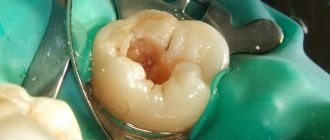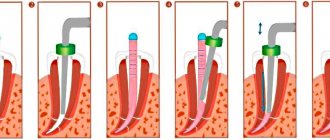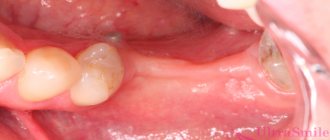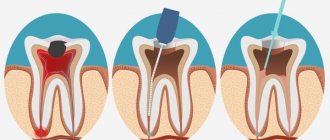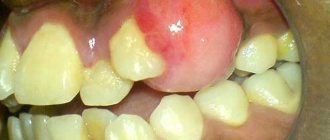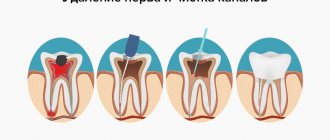.
If the tooth canals were initially filled poorly, which led to the development of infection, then root canal retreatment will be required to save the tooth. Sometimes, during the initial treatment, the dentist simply fails to correctly identify the source of the infection and effectively remove it. The structure of the tooth and depressurization of the installed filling can also affect the effectiveness of treatment. Let's look at all the reasons and conditions for refilling and the conditions for the reliability of treatment.
Refilling is performed under anesthesia
Features of canal retreatment
A special case in the process of endodontic treatment is the process when the dentist has to refill the canals of a previously treated tooth. And to do this you will need to get rid of the old filling and remove the filling material from them.
During the work, complications may arise for both adults and children, in the form of breakage of the flexible rod used to clean the work area.
This can happen if the filling is too dense and tightly attached to the walls of the root canal.
Another difficult moment for the doctor is the refilling of curved dental canals. Cleaning in this case can lead to damage to its walls or breakage of the instrument directly in the tooth. This is not a death-defying moment in endodontics, but it will require much more effort to achieve quality treatment. Therefore, a professional in his field is simply obliged to warn the patient about the complexity of the procedure even before it begins.
Signs of canal infection
In some cases, patients can independently determine the presence of problems with a previously treated tooth. The main signs of canal infection are:
- pain that did not go away after treatment or occurred some time after it;
- a feeling of fullness in the gums, discomfort when pressing on the tooth;
- the presence of swelling, swelling on the gums, as well as the formation of a fistulous tract (cyst breakthrough);
- changing the shade of the dental crown from light to gray. This may indicate dentin destruction;
- persistent unpleasant odor.
If you have the above symptoms, you should not waste time by self-medicating. At the IMEZA clinic, the patient can count on a quick, accurate diagnosis and adequate treatment.
Why is dental canal refilling performed?
Retreatment of tooth canals is simply necessary in cases when:
- after treatment, pain returns;
- The areas of inflammation are clearly visible on the x-ray;
- incomplete closure of the channels is visible.
The causes of complications that may arise during tooth treatment include inaccuracies that doctors make at each stage of endodontic treatment.
In preparation:
- infection in the root canal;
- inability to access its basis;
- pathological holes in the bottom of the tooth and its walls, made as a result of a doctor’s mistake.
During processing, problems can arise when dentin gets into the canals, the middle part of the canal expands too much with internal curvature of the root, damage to the root walls, rupture of the physiological narrowing, or splitting of the instrument.
Problems requiring refilling
When filling a canal, complications are associated with its heterogeneous (incomplete) filling, carrying the filling material beyond the boundaries of the hole, and a longitudinal fracture of the tooth root. Due to inexperience, the doctor may overestimate the total length of the canal or not completely clean it, which will lead to the development of inflammation.
The process of resealing canals
Features of modern endodontic treatment for the most part give very good results, but dentists can sometimes make mistakes, so refilling dental canals is not such a rare occurrence. Today, dentists use several methods to carry it out.
When using mechanical methods, dentists use special tools - an endodontic motor and an apex locator. The filling material often includes antiseptic components. The doctor must carefully and correctly completely fill the cleaned canal with the material in order to stop the development of inflammation.
The process of re-medication involves the use of products that contain organic solvents and can soften a pre-installed filling. It only takes a few minutes to destroy the filling material. If a cement-based filling was used for filling, it can be removed using endo-nozzles with ultrasound. The procedure is performed in one visit to the dental office.
Sealed canal mouths
New technologies
Today, modern dentistry can offer such a service as re-treatment of dental canals under a microscope. The use of high-tech equipment helps doctors multiply their work area, resulting in increased treatment efficiency and the quality of the procedure.
Using a microscope will allow you to avoid damage to healthy tissue and carry out treatment in a delicate manner.
A dental microscope is equipped with magnifying glasses through which the tooth can be examined under multiple magnification. With this treatment, the doctor will easily see all areas of the lesion that simply cannot be seen with the naked eye. A microscope is an indispensable dentist's assistant, which helps to carry out quick, painless and safe refilling of canals.
Unsealing under the anchor pin
The use of anchor pins occurs in parallel with obturation of the tooth root canal. To install the structure, the filling is left in the lower part of the root (provided that it is installed well and hermetically).
In a dental clinic, this procedure is carried out in two visits. First, the doctor mechanically processes the canals, at the second stage he softens the filling material with medication, after which he cleans the passage with an endo-instrument, which is moistened in the same softening solution. After this treatment, the doctor places a cotton swab dipped in the medicine. A follow-up visit takes place two days later. Then the cotton swab is removed and the tooth canals are refilled.
Unsealing under the anchor pin
Unsealing the root canal
Unsealing of root canals (disobturation) is carried out when a tooth with previously treated roots is subject to re-processing. The main reasons for this phenomenon are poor-quality filling of root canals, resorption of filling material, excessive removal of the filling beyond the apex of the root, as it irritates periodontal tissue (tooth ligaments), incomplete removal of the dental nerve, root perforation, insufficient instrumental and medicinal treatment of root canals, infection. into the dental ligament with the development of periodontitis, which is accompanied by pain in the tooth or may be asymptomatic, and pathological changes are revealed on an x-ray. Unsealing canals can be simple or complex. Simple disobturation is used if the canal is filled with hardening paste. To perform this, special medications are used that help soften the filling material and contain organic solvents (solvent preparations). They are applied directly to the root filling, and it changes its chemical structure. After a couple of minutes, the material is easily removed using endodontic instruments.
For example, the Septodont company produces the following solvent preparations: Endosolve R for unsealing canals filled with resorcinol-formalin paste, Endosolve E for zinc oxide eugenol agents, Guttasolv for gutta-percha pins. The latter contains eucalyptol, which dissolves gutta-percha.
Complex unsealing is used when the canal was previously filled with cement or resorcinol-formalin paste. This procedure is longer and more painstaking than simple disobturation. In this case, the solvent substance is left in the canal for several days, covering it with a temporary filling. After this, the filling material is removed from the roots mechanically, as it becomes softer and begins to crumble.
For the final removal of the root filling after the use of solvents, burs and endodontic instruments (reamers or files) are used. The file in the canal is turned clockwise, then a movement is made against it and removed, removing along with it a portion of the filling material. For more active advancement, the tip of the instrument is cut off. Each time the file is advanced by 2-3 mm so as not to break it and damage the canal walls. The manipulation is repeated until the filling is completely removed from the root.
Complex disobturation can be carried out in one visit using special endo-attachments using ultrasound.
Conditions for effective retreatment and longevity of the tooth
Subject to professional endodontic treatment, compliance with all techniques and the use of high-quality materials, the tooth will serve for many years. After the canals have been re-treated, the patient must follow all procedures recommended by the doctor to restore the coronal part of the tooth (installation of a crown or inlay).
If, after a qualified and correct procedure, your tooth still hurts when biting, then you should not immediately panic. Some discomfort may persist for 3-5 days after filling. When a tooth does not stop hurting for a long time, you should consult a doctor. Before visiting the dental office, the patient can take a pain reliever on his own.
A special point is lingering pain, which torments the patient for several months or even years and does not go away with painkillers and physiotherapy. The main reason for this exacerbation is the treatment of canals in one session. It is simply physically impossible to immediately influence additional channels and process them poorly. This leads to the fact that parts of the infected pulp remain in the tooth and a chronic infection develops.
All questions that patients have regarding repeated endodontic treatment are based precisely on the appearance of pain, increased sensitivity and swelling at the treatment site. If the x-ray shows that after treatment of the canals there is no positive dynamics or there are unsealed areas, then this indicates the need for mandatory re-treatment.
Stages of canal retreatment
The procedure for re-treating the canals begins with providing access to them: removing the crown or removing (drilling out) the old filling, removing the stump inlays and pins. Then the canal cavities are freed from the filling material.
One of the stages that determines the quality of endodontic treatment is the correct measurement of the working depth of each canal. The most accurate result is obtained when using an apex locator - an electronic device connected via an electrode to a radiopaque K-file (a thin instrument immersed in the canal). As the K-file approaches the lowest point of the canal (apical constriction), the apex locator signal intensifies. An x-ray helps to clarify the readings of the device.
To ensure proper filling of the canal and adhesion (adhesion) of the filling material to its walls, preliminary mechanical treatment is necessary. Cleaning is done with hand instruments (high risk of breakage) or using an endodontic tip into which nickel-titanium profiles (thin drills) are inserted.
The intensity of rotation of the profiles is controlled by a micromotor, which triggers a reverse if the permissible pressure is exceeded. This method guarantees the absence of perforations, nicks and eliminates breakage of the instrument in the canal. Ultrasonic scalers and dentin softeners are used as auxiliary measures. This promotes maximum preservation of healthy tissue.
An important component of the canal revision process is their sterilization. The cavity is thoroughly washed and disinfected with antiseptics. In the presence of inflammatory formations, the following measures can be taken:
- opening the gums and excision of the root apex or complete removal of one of the roots (hemisection);
- laser removal of infected tissue;
- sanitation of channels through electrophoresis with calcium and copper ions.
After sterilization, filling material is placed. If the working length is incorrectly determined during machining, the top of the channel opens and the material flows beyond its limits. As a result, the patient will be bothered by prolonged pain, inflammation and neuralgia. At the IMEZA clinic, such errors in treatment are excluded.
The retreatment procedure is associated with additional damage to the coronal part, therefore, in some cases, its position is strengthened using an intracanal pin. Manipulation is possible if the layer of dentin surrounding the pin is at least 2 mm. Installation includes the following steps:
- preparing the bed using a calibration tool;
- adjusting the length of the pin;
- etching and drying the bed;
- applying adhesive material directly to the pin or into the cavity of the bed;
- installation of the rod, polymerization of the adhesive mass.
After completing the canal filling work, the dental cavity is closed with a temporary filling. At the next visit, the doctor begins to restore the upper part of the tooth using an artificial crown, inlays or volumetric restoration techniques.
After treatment, discomfort when biting on a tooth may persist for 3-5 days. If there are no complications, you should return for a routine examination in a year.
